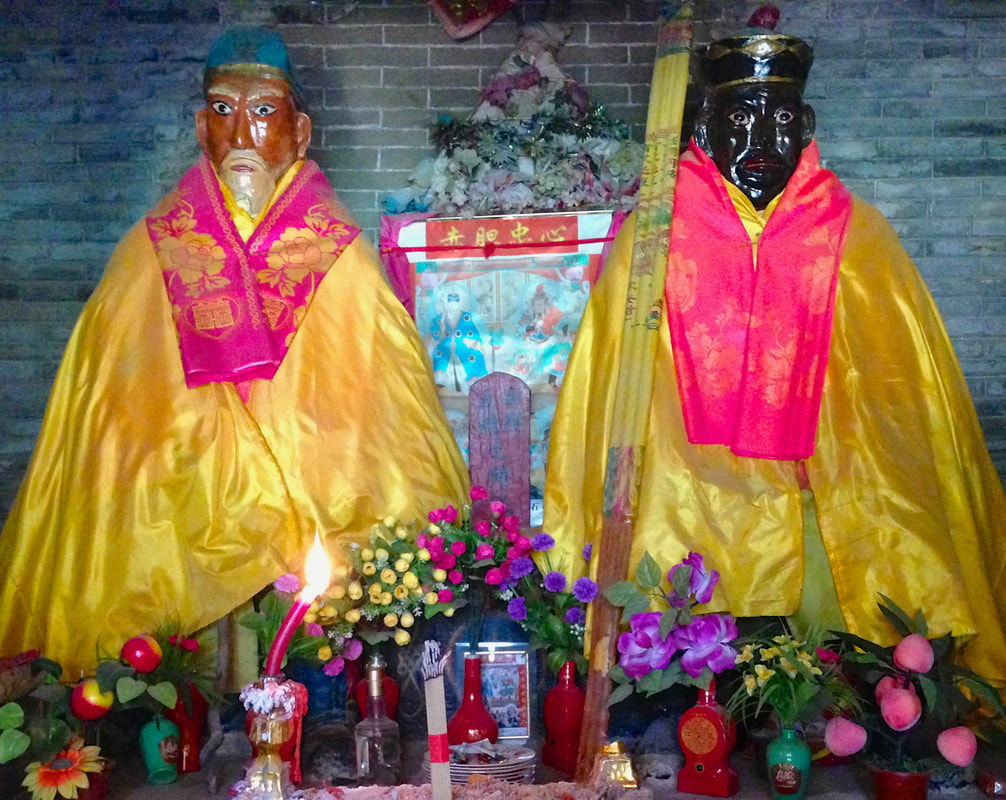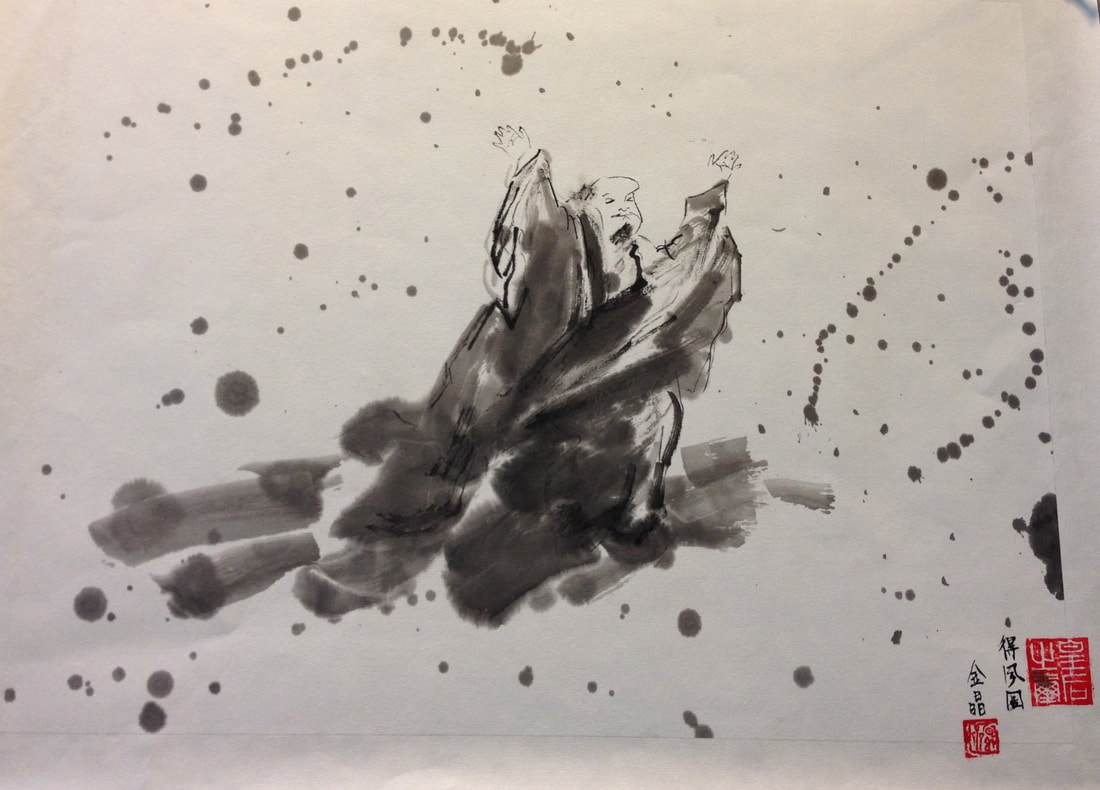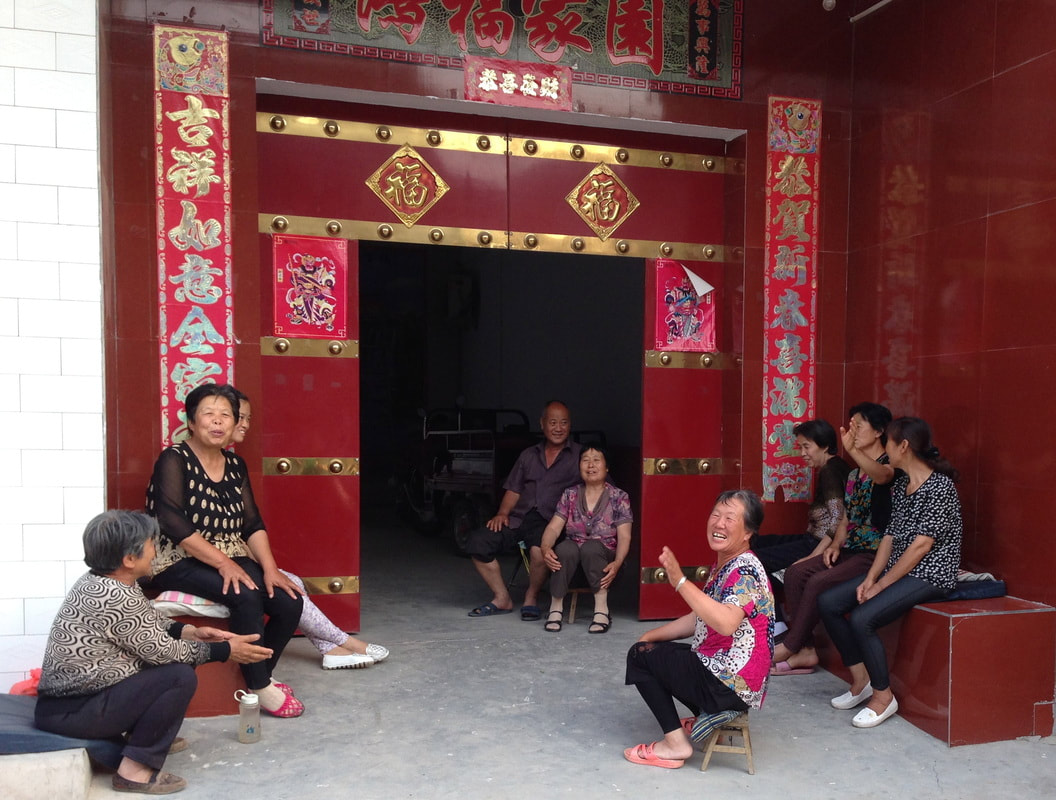- Home
- Process Worldview
- Community
- Art and Music
- Whitehead and Process Thinking
- Podcasts
- Spirituality
- Ecological Civilization
- Education
- Contact
- Social Justice
- Science
- Animals
- Sacred Poems
- Whitehead Videos
- Index of All Titles
- Practicing Process Thought
- Process Spirituality: A Spiritual Alphabet
- Recent Posts
|
切始于舞蹈
安妮•英格拉姆 博士
(谢邦秀 译)
Chinese version of “It All Starts with Dancing”, translated by Xie Bangxiu, Wuhan, China.
怀着“城市空气质量可怕、处处是拥挤的人群”这种模糊印象,我平生首次来到了中国。在一周多一点的时间里,我所见到的却是难以用言语或照片捕捉到的美。我遇见了令人惊讶的人,他们真诚地致力于将中国转变成一个更生态的文明社会。无论我们走到哪里,都受到慷慨、殷勤、热情、友善的款待。
作为一个从事环境研究的教授,我被要求谈“环境人文学能从中国学到什么?”以下是我的一些简要的初步印象。
爱大地。 在罗(Luo Jao)村,一家的主人小心翼翼地照管着他家门口的一些盆栽植物,院中还绕一棵树搭了一个棚子。(1)在罗村外的树林里,有一座祭司山神和土地神的小庙。(2)一位主业务农但自学成才的画家创作出精美、自然的画作,笔法古典,时有现代事物更新:这里一台拖拉机,那里一辆小轿车,但这些都只是衬托树木、山川和河流的细枝末节。(3)在永济(Yongji)外的一个村,一位深知自然环境的当地导游带我们登上了附近的一座山。我们见到了他的一位朋友,他在山上种了20,000多棵树——不为盈利,但求“与朋友分享果实”。在珠海联合国际学院,学生们为餐厅绘制了宣传“低碳饮食”的信息性海报。(4)在普陀山,甚至当地一个池塘里的锦鲤亦是信徒虔心敬献的结果。
“珍视过去”。 中国文化悠远、丰富,有着崇尚和谐、敬重自然的哲学及精神传统。在纪念老子著《道德经》的地方,石板上的斑文倡导自然与“道”相关联。(5)会同村莫氏宗祠的引导牌详细记载了该宗祠、该村以及莫家的历史。国际联合学院所致力于从事的全人教育包括借助于一种传统的弦乐器“古琴”教音乐、箭术、皮影戏和绘画。(6)广州的两所小学分别以两种中国特色的文化为重心打造校园文化:一所因其武术教育享誉世界,另一所则以翰墨教育立校,两校年幼的孩子们都展现了骄人的才华与成就。(7)在普陀山如意阁(Ruyige)佛教中心,甚至一日三餐都是细腻关照和谐与美的鲜活实例。(8)
共同体。 在永济附近的一个村里,一切都始于舞蹈。几年前,当地领导郑冰(Zheng Bing)在一次进城的途中看见女人们傍晚结伴跳舞,因此她想,何不在我们村里也这么做?这样,从初步涉足尝试到成规模的共同体活动,她打造了一整套综合网络,包含培训并支持生态农业、信用合作社、手工艺品合作社、日间托老所、乃至接待、教育、提供解决日常争端安全渠道的辩论社。在弘农(Hongnong)学院,何慧丽(He Huili)教授将道德教育与乡村卫生保健、农业指导以及多代、实地项目相结合。这两个乡村处处彰显着共同体意识。在弘农学院,你能看到奶奶、婴儿、妈妈、孩子聚在院子里荡秋千,农民、银行家、政府官员在下午的研讨会上与外宾切磋、商讨。(9)在永济附近郑冰的村里,邻居们在晚餐前聚在前面的人行道上闲聊。(10)
我们能够从这些简单的例子中学到很多。对大地的爱滋养着小盆栽植物、尊崇着自然的精神、欣赏着景观美学、倡导着自觉的决策,即使是在进餐之时。致力于珍视过去内含着道家的智慧、学生对古典绘画技艺和主题的聚精会神、全校师生致力于继承富含意蕴的书法传统、亦或一个捕捉到和谐之美和佛家觉悟的盘子。我期望每一个读到此文的读者都得以体验到我们所到之处亲历的丰富、慷慨和热忱:他们毫不动摇地殷勤好客,我们在品尝一杯杯绿茶的过程中了解到点滴有关他们的生活
安妮•英格拉姆 博士
(谢邦秀 译)
Chinese version of “It All Starts with Dancing”, translated by Xie Bangxiu, Wuhan, China.
怀着“城市空气质量可怕、处处是拥挤的人群”这种模糊印象,我平生首次来到了中国。在一周多一点的时间里,我所见到的却是难以用言语或照片捕捉到的美。我遇见了令人惊讶的人,他们真诚地致力于将中国转变成一个更生态的文明社会。无论我们走到哪里,都受到慷慨、殷勤、热情、友善的款待。
作为一个从事环境研究的教授,我被要求谈“环境人文学能从中国学到什么?”以下是我的一些简要的初步印象。
爱大地。 在罗(Luo Jao)村,一家的主人小心翼翼地照管着他家门口的一些盆栽植物,院中还绕一棵树搭了一个棚子。(1)在罗村外的树林里,有一座祭司山神和土地神的小庙。(2)一位主业务农但自学成才的画家创作出精美、自然的画作,笔法古典,时有现代事物更新:这里一台拖拉机,那里一辆小轿车,但这些都只是衬托树木、山川和河流的细枝末节。(3)在永济(Yongji)外的一个村,一位深知自然环境的当地导游带我们登上了附近的一座山。我们见到了他的一位朋友,他在山上种了20,000多棵树——不为盈利,但求“与朋友分享果实”。在珠海联合国际学院,学生们为餐厅绘制了宣传“低碳饮食”的信息性海报。(4)在普陀山,甚至当地一个池塘里的锦鲤亦是信徒虔心敬献的结果。
“珍视过去”。 中国文化悠远、丰富,有着崇尚和谐、敬重自然的哲学及精神传统。在纪念老子著《道德经》的地方,石板上的斑文倡导自然与“道”相关联。(5)会同村莫氏宗祠的引导牌详细记载了该宗祠、该村以及莫家的历史。国际联合学院所致力于从事的全人教育包括借助于一种传统的弦乐器“古琴”教音乐、箭术、皮影戏和绘画。(6)广州的两所小学分别以两种中国特色的文化为重心打造校园文化:一所因其武术教育享誉世界,另一所则以翰墨教育立校,两校年幼的孩子们都展现了骄人的才华与成就。(7)在普陀山如意阁(Ruyige)佛教中心,甚至一日三餐都是细腻关照和谐与美的鲜活实例。(8)
共同体。 在永济附近的一个村里,一切都始于舞蹈。几年前,当地领导郑冰(Zheng Bing)在一次进城的途中看见女人们傍晚结伴跳舞,因此她想,何不在我们村里也这么做?这样,从初步涉足尝试到成规模的共同体活动,她打造了一整套综合网络,包含培训并支持生态农业、信用合作社、手工艺品合作社、日间托老所、乃至接待、教育、提供解决日常争端安全渠道的辩论社。在弘农(Hongnong)学院,何慧丽(He Huili)教授将道德教育与乡村卫生保健、农业指导以及多代、实地项目相结合。这两个乡村处处彰显着共同体意识。在弘农学院,你能看到奶奶、婴儿、妈妈、孩子聚在院子里荡秋千,农民、银行家、政府官员在下午的研讨会上与外宾切磋、商讨。(9)在永济附近郑冰的村里,邻居们在晚餐前聚在前面的人行道上闲聊。(10)
我们能够从这些简单的例子中学到很多。对大地的爱滋养着小盆栽植物、尊崇着自然的精神、欣赏着景观美学、倡导着自觉的决策,即使是在进餐之时。致力于珍视过去内含着道家的智慧、学生对古典绘画技艺和主题的聚精会神、全校师生致力于继承富含意蕴的书法传统、亦或一个捕捉到和谐之美和佛家觉悟的盘子。我期望每一个读到此文的读者都得以体验到我们所到之处亲历的丰富、慷慨和热忱:他们毫不动摇地殷勤好客,我们在品尝一杯杯绿茶的过程中了解到点滴有关他们的生活










